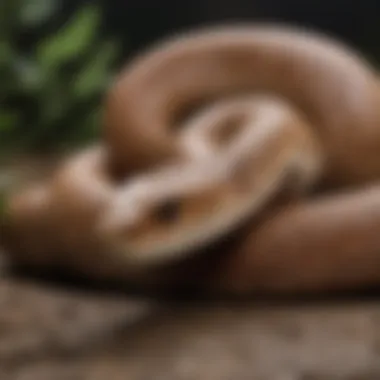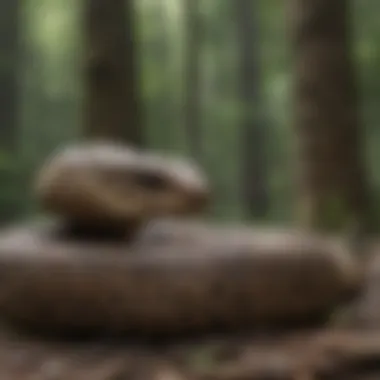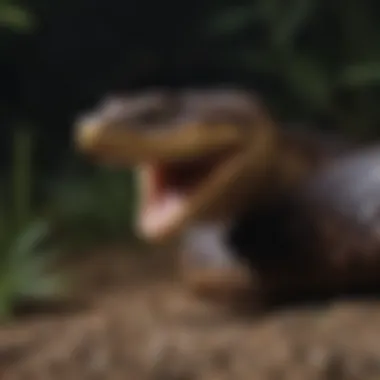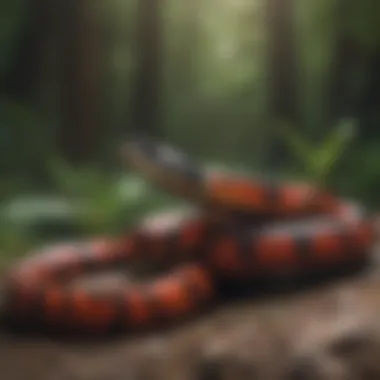Unveiling the Enigmatic Poisonous Snakes of Northern Virginia


Animal Species Profile
In the lush landscapes of Northern Virginia, a diverse array of venomous snakes silently slither beneath the surface, commanding both fear and fascination. These reptiles, such as the Northern Copperhead and Eastern Cottonmouth, boast distinct physical characteristics that aid them in camouflaging within their natural habitats. Their scales, ranging from earthy browns to vibrant copper tones, perfectly blend with the woodland scenery, making spotting them a challenging endeavor for even the keenest observer. Their diamond-shaped heads and pit organs contribute to their unique appearance, hinting at their tactical hunting capabilities in the dense undergrowth.
Exploring further, these snakes predominantly inhabit wooded areas, marshes, and streams, where they find ample cover and prey. The Northern Copperhead, known for its preference for rocky terrains, often basks near water bodies to regulate its body temperature. In contrast, the Eastern Cottonmouth favors swampy regions and wetlands, where its semi-aquatic lifestyle thrives. Their distribution across different ecosystems underscores their adaptability and resilience in diverse environments in Northern Virginia.
When it comes to behavior, these venomous serpents exhibit solitary tendencies, with minimal interactions except during the mating season. Their hunting techniques, primarily relying on ambush and quick strikes, highlight their stealth and agility in capturing prey. These snakes' intriguing behavior patterns offer a glimpse into their survival strategies and ecological roles within the delicate balance of the region's ecosystem.
Conservation & Wildlife Efforts
While these venomous snakes often evoke fear in the hearts of residents and visitors, they play a crucial role in the local ecology of Northern Virginia. Understanding the conservation status of these species is vital for implementing effective protection measures and mitigating potential threats to their existence. The Northern Copperhead and Eastern Cottonmouth face numerous challenges, including habitat loss due to urban development and human encroachment. Additionally, indiscriminate hunting and road mortality pose significant risks to their populations.
Conservation initiatives spearheaded by local wildlife organizations aim to address these pressing issues and ensure the sustainable coexistence of humans and snakes. Efforts such as habitat restoration, educational campaigns, and snake-friendly infrastructure projects have shown promising results in promoting snake conservation. Success stories of increased snake populations in protected reserves and wildlife sanctuaries serve as beacons of hope for the future of these remarkable reptiles in Northern Virginia.
Animal Behavior & Psychology
Delving into the intricate world of venomous snakes' behavior unveils a fascinating tapestry of communication, reproduction, and cognitive abilities. While these creatures lack vocalizations, they communicate through a combination of visual cues, body language, and chemical signals. The elaborate courtship rituals of male snakes and maternal care practices reflect their complex social interactions and reproductive strategies.
Exploring further, studies suggest that venomous snakes exhibit remarkable cognitive abilities and problem-solving skills, challenging conventional notions of reptilian intelligence. Their adeptness in navigating complex environments, hunting strategies, and social hierarchies highlight their cognitive prowess and adaptability. Moreover, research exploring emotional intelligence in snakes sheds light on their capacity for empathy and social bonding, emphasizing the multifaceted nature of these enigmatic creatures.
Unique Facts & Trivia
Uncovering the lesser-known aspects of venomous snakes in Northern Virginia reveals a treasure trove of unique facts and trivia that intrigue even the most seasoned herpetologist. Did you know that the Northern Copperhead possesses the ability to adjust the color of its scales based on environmental factors, enhancing its camouflage skills? Or that the Eastern Cottonmouth exhibits a distinctive 'gaping' behavior when threatened, displaying its fangs as a warning sign?
Beyond their physical adaptations, these snakes showcase surprising behaviors, such as 'frog luring' in the Eastern Cottonmouth, where it imitates the movement of a prey item to attract amphibians. Their quirky habits, like 'tail vibration' for communication and thermoregulation, add a layer of fascination to their already mystique-laden reputation. Furthermore, the record-breaking feats of these snakes, from the longest fang size to the most potent venom potency, underscore their evolutionary success and biological significance.
Pet Care & Tips
For enthusiasts interested in owning non-venomous snake species as pets in Northern Virginia, navigating the realm of pet care requires careful consideration and dedication. Selecting the right snake based on temperament, size, and activity level is essential to ensure a harmonious fit with your lifestyle. Establishing a suitable habitat with proper temperature gradients, hiding spots, and enrichment activities is crucial for your pet snake's well-being and happiness.
Ensuring your snake's health and longevity involves adhering to a balanced diet, regular veterinary check-ups, and monitoring environmental conditions for signs of distress or illness. Incorporating positive reinforcement techniques and behavioral enrichment strategies can strengthen the bond between you and your pet snake, fostering trust and companionship. By prioritizing responsible pet ownership and investing time and effort in providing a nurturing environment, you can experience the joys of snake companionship and appreciation for these captivating animals.
Understanding Poisonous Snakes
Types of Poisonous Snakes
Eastern Copperhead
When discussing venomous snakes, the Eastern Copperhead stands out prominently in Northern Virginia. Its key characteristic lies in its distinctive coloration patterns, facilitating easy recognition in natural habitats. The unique feature of the Eastern Copperhead is its adaptability to varied environments, making it a beneficial addition to this discourse. Despite its advantages in ecological balance, encountering an Eastern Copperhead poses potential risks due to its venomous nature. Proper identification and caution are imperative when encountering this species.
Northern Cottonmouth


Within the realm of venomous reptiles, the Northern Cottonmouth asserts its presence in Northern Virginia's landscape. Recognizable by its head shape and size variations, the Northern Cottonmouth's inclusion in this article serves to highlight its significance in the local ecosystem. This snake's unique feature lies in its preference for water bodies, offering valuable insights into its behavioral patterns. Understanding the advantages and disadvantages of encountering a Northern Cottonmouth aids in promoting effective safety measures within these habitats.
Timber Rattlesnake
As we navigate the forests of Northern Virginia, the Timber Rattlesnake emerges as a key player in the region's biodiversity. Its distinctive coloration patterns and size variations make it a popular subject of study among wildlife enthusiasts. The Timber Rattlesnake's unique feature of thermoregulation tactics provides a critical perspective on its behavioral adaptations. While observing these reptiles adds to the richness of the ecosystem, awareness of the advantages and disadvantages of their presence is pivotal for maintaining ecological harmony.
Northern Copperhead
Among the venomous residents of Northern Virginia, the Northern Copperhead holds a significant position. Its coloration patterns, head shape, and size variations contribute to its distinctiveness within the snake community. The unique feature of the Northern Copperhead lies in its feeding habits, shedding light on its dietary preferences and hunting techniques. Understanding the advantages and disadvantages of the Northern Copperhead's presence aids in fostering a respectful coexistence within their shared habitats.
Characteristics and Identification
Coloration Patterns
In the realm of snake identification, coloration patterns play a vital role. By examining the color variations of venomous snakes in Northern Virginia, enthusiasts can distinguish between species efficiently. The key characteristic of coloration patterns lies in their role as warning signals, alerting potential predators and humans to their presence. While these patterns provide advantages in survival, they also have disadvantages as they can sometimes lead to misidentification.
Head Shape
A snake's head shape is a crucial determinant in species identification and behavior analysis. Understanding the head morphology of venomous snakes aids in differentiating them from non-venomous counterparts. The key characteristic of head shape lies in its connection to venom delivery mechanisms, influencing the snake's predatory strategies. While head shape offers advantages in classification, it also presents disadvantages when ambiguity arises in identifying certain species.
Size Variations
Size variations among snakes contribute significantly to their ecological roles and interactions within the food chain. By exploring the diverse sizes of venomous snakes in Northern Virginia, researchers can unveil nuanced details about their growth patterns and habitat preferences. The key characteristic of size variations lies in its impact on the snake's reproductive success and predatory capabilities. While size variations offer advantages in adaptation, they also pose disadvantages in terms of vulnerability to environmental changes.
Venomous Nature
Venom Composition
Delving into the composition of snake venom provides critical insights into their predatory strategies and defensive mechanisms. Examining the venom components of Northern Virginia's poisonous snakes elucidates the potency and effects of their toxins. The key characteristic of venom composition lies in its biochemical properties, dictating the severity of envenomation in bite victims. While understanding venom composition aids in developing antivenom and treatment protocols, it also comes with the risk of accidental exposure during research.
Effects on Humans
Analyzing the effects of snake venom on humans sheds light on the potential dangers posed by encounters with venomous species. Understanding how snake toxins affect the human body informs medical responses and preventative measures. The key characteristic of these effects lies in their systemic impact, ranging from localized tissue damage to life-threatening complications. While knowledge of the effects on humans is crucial for first responders and healthcare providers, it also instills a sense of caution and respect for these reptiles.
Treatment Options
Exploring treatment options for snakebite incidents is a pivotal aspect of snake research and wildlife management. Investigating the efficacy of antivenom therapies and supportive care enhances the chances of recovery for bite victims. The key characteristic of treatment options lies in their timeliness and specificity to the snake species involved, influencing the overall prognosis. While having diverse treatment modalities offers advantages in addressing varying clinical presentations, it also presents challenges in accessing specialized care in remote areas.
Habitats of Poisonous Snakes
Exploring the habitats of poisonous snakes in Northern Virginia is crucial for understanding the environment these reptiles thrive in. This section delves into the specific elements that make these habitats ideal for snakes while also highlighting the considerations individuals need to keep in mind when encountering them. Northern Virginia boasts diverse landscapes that cater to different species of venomous snakes, each with its preferred environment.
Preferred Environments


Forested Areas
Forested areas are a key habitat for poisonous snakes in Northern Virginia due to their abundant vegetation and shelter opportunities. These areas offer camouflage and protection for snakes, allowing them to ambush prey effectively. Forested regions provide a rich source of food and favorable temperature regulation for these reptiles. However, navigating through forested areas increases the risk of encountering snakes, urging visitors to stay vigilant and cautious.
Water Bodies
Water bodies also play a significant role in the habitats of poisonous snakes. Snakes frequent water bodies for hunting opportunities and regulating body temperature. The damp environment near water sources attracts various species of venomous snakes, promoting their presence in these areas. However, the proximity to water bodies poses a higher risk of snake encounters, necessitating individuals to exercise caution during outdoor activities near rivers or lakes.
Rocky Terrains
Rocky terrains present a unique habitat for poisonous snakes in Northern Virginia. The rugged landscape offers ideal hiding spots and basking locations for snakes. Additionally, rocky terrains provide a diverse range of potential prey, supporting the sustenance of these reptiles. While rocky terrains offer distinct advantages for snakes, the uneven ground and crevices increase the likelihood of surprise encounters with venomous species, emphasizing the importance of careful observation and movement in such areas.
Nesting and Reproduction
Mating Behaviors
The mating behaviors of poisonous snakes significantly contribute to their survival and population growth in Northern Virginia. Understanding the intricate rituals and courtship displays of these snakes provides insight into their reproductive success. Mating behaviors are essential for species recognition, partner selection, and successful breeding among venomous snakes. However, these behaviors also increase the likelihood of encountering snakes during their mating seasons, requiring individuals to be observant and respectful of their natural rhythms.
Gestation Period
The gestation period of venomous snakes is a critical phase in their reproductive cycle. This period varies among species and influences the number of offspring born. Snakes undergo physiological changes during gestation to ensure the development and nourishment of their young. The gestation period reflects the resilience and adaptability of these reptiles to diverse environmental conditions. While the gestation period showcases the reproductive prowess of venomous snakes, it also poses a potential risk to individuals unknowingly coming across gravid females, underscoring the need for caution in snake-prone areas.
Offspring Care
Offspring care among venomous snakes highlights their parental instincts and protective behaviors towards their young. From nest building to defending offspring against predators, these snakes exhibit remarkable dedication to ensuring the survival of their progeny. Offspring care enhances the survival rates of young snakes, contributing to the overall sustainability of the snake population in Northern Virginia. While witnessing offspring care can be a captivating sight, individuals must respect the boundaries of these snake families to avoid provoking defensive responses and ensure the well-being of both adults and young snakes.
Behavioral Patterns
Behavioral Patterns play a crucial role in understanding the behavior of poisonous snakes in Northern Virginia. By examining their thermoregulation tactics, feeding habits, and more, researchers and enthusiasts can glean valuable insights into these fascinating creatures. Understanding how snakes behave in different environments is key to coexisting safely. Behavioral Patterns shed light on how these reptiles interact with their surroundings, prey, and potential threats.
Thermoregulation Tactics
Basking in Sunlight
Basking in sunlight is a pivotal behavior exhibited by poisonous snakes in Northern Virginia. This thermoregulation tactic allows snakes to regulate their body temperature, crucial for their metabolic processes. The key characteristic of basking is its role in maintaining optimal body temperature for various physiological functions. Snakes choose sunlight exposure strategically based on their need for warmth and energy. This behavior aids in digestion, movement, and overall well-being, ensuring snakes can thrive in their habitats.
Seeking Shade
Seeking shade is another vital thermoregulation strategy adopted by poisonous snakes. This behavior helps snakes cool down and avoid overheating in excessively warm conditions. The key characteristic of seeking shade lies in snakes' ability to find refuge from intense heat, preventing heat-related stress. By moving to shaded areas, snakes can balance their temperature and conserve energy, promoting their survival in diverse environmental settings.
Burrowing Behavior


Burrowing behavior is a unique thermoregulation tactic practiced by some Northern Virginia snakes. This behavior involves snakes digging into the ground to escape extreme temperatures or find shelter. The key characteristic of burrowing is its effectiveness in providing insulation and protection against temperature fluctuations. While burrowing offers snakes a secure retreat, it can also limit their mobility and expose them to certain predators, showcasing a trade-off between safety and freedom in their behavioral repertoire.
Feeding Habits
Diet Composition
Poisonous snakes in Northern Virginia exhibit varied diet compositions, depending on their species and habitat. The key characteristic of diet composition lies in the diversity of prey consumed, ranging from small rodents to insects. Snakes' feeding habits are crucial for maintaining their energy levels and sustaining their predatory nature. Understanding the diet composition of these snakes is essential for comprehending their ecological role and nutritional requirements.
Hunting Techniques
Hunting techniques employed by poisonous snakes reflect their evolutionary adaptations for capturing prey. The key characteristic of hunting lies in the sophisticated strategies snakes utilize, such as ambush predation or constriction. These techniques highlight the efficiency and precision with which snakes hunt, securing their food source while minimizing energy expenditure. By honing their hunting skills, snakes optimally fulfill their dietary needs and enhance their survival prospects.
Consumption Frequency
Consumption frequency is a vital aspect of the feeding behavior of Northern Virginia snakes. The key characteristic here is the regularity with which snakes consume food to meet their metabolic demands and growth requirements. Understanding the consumption frequency of these snakes provides insights into their foraging patterns, energy utilization, and reproductive success. By assessing how often snakes feed, researchers can gauge their overall health status and ecological impact within their respective ecosystems.
Encountering Poisonous Snakes Safely
When venturing into the wilderness of Northern Virginia, understanding how to encounter poisonous snakes safely is paramount. The unpredictable presence of these venomous reptiles elevates the need for caution. By adhering to specific safety measures, individuals can minimize the risks associated with snake encounters and enjoy nature responsibly. Navigating through snake habitats requires a blend of awareness, respect for wildlife, and preparedness. Learning the nuances of encountering poisonous snakes safely ensures a harmonious coexistence between humans and these creatures.
Precautionary Measures
Wearing Appropriate Footwear
Wearing appropriate footwear plays a pivotal role in protecting oneself while exploring environments inhabited by venomous snakes. The choice of footwear can determine the level of safety when treading through snake territory. Sturdy, closed-toe shoes or boots with thick soles offer essential protection against potential snake bites. The robust design of suitable footwear shields the wearer's feet from snake fangs and rough terrain, reducing the likelihood of injury. Prioritizing the selection of adequate footwear is a fundamental step towards creating a secure barrier between individuals and venomous snakes in their natural habitats.
Watchful Steps in Natural Settings
Practicing watchful steps in natural settings contributes significantly to minimizing the risk of unexpected snake encounters. Vigilance and attentiveness are key aspects of safe exploration in snake-prone areas. By staying observant of the surroundings, individuals can proactively detect and avoid potential snake habitats or resting spots. Taking deliberate, cautious steps while exploring wooded areas or rocky terrains can enhance personal safety and diminish the chances of unintentional snake interactions. Implementing a mindful approach to movement in natural settings underscores the importance of staying alert and responsive to environmental cues.
Avoiding Provocation
Avoiding provocation of snakes serves as a crucial safeguarding measure against escalating confrontations with these reptiles. Respect for the natural behavior and space of venomous snakes is essential for preventing conflicts and minimizing risks. Refraining from behaviors that may agitate or startle snakes, such as making sudden movements or loud noises, promotes peaceful cohabitation in shared habitats. Cultivating a non-intrusive attitude towards snakes underscores the significance of maintaining a harmonious presence in their ecosystems. Embracing a harmonious coexistence ethos emphasizes the importance of observing and respecting snake behavior from a safe distance.
Emergency Response
In situations where snake encounters escalate into bite incidents, prompt and informed actions become critical for ensuring favorable outcomes. A structured emergency response plan equips individuals with the necessary knowledge and guidelines to address snake bite emergencies effectively. Understanding the steps involved in identifying snake bites, seeking immediate medical assistance, and administering appropriate first aid measures can potentially save lives. Implementing a well-prepared emergency response strategy elevates personal safety levels and promotes a swift recovery process for individuals affected by snake bites.
Identifying Bites
The ability to identify snake bites promptly is crucial for initiating timely intervention and treatment. Recognizing the distinctive marks and symptoms associated with venomous snake bites is essential for accurate diagnosis and medical response. Being able to differentiate between venomous and non-venomous snake bites empowers individuals to take swift actions towards securing medical attention and implementing relevant treatment protocols. Enhancing awareness regarding the visual cues and physiological effects of snake bites reinforces the importance of vigilance and proactive healthcare decision-making in critical situations.
Seeking Medical Help
Seeking immediate medical help after a snake bite is a non-negotiable step in mitigating the impact of venom injection and safeguarding one's health. Professional medical intervention plays a vital role in assessing the severity of snake bites, administering antivenom treatments, and monitoring recovery progress. Prioritizing timely medical assistance ensures that individuals receive appropriate care tailored to the specific snake bite circumstances, reducing the risks of complications and promoting rapid healing. Acknowledging the significance of swift medical intervention underscores the proactive approach towards prioritizing personal well-being in snake-related emergencies.
First Aid Procedures
Having a sound understanding of first aid procedures for snake bites empowers individuals to deliver immediate assistance in critical situations. Basic first aid techniques, such as cleaning the bite wound, immobilizing the affected limb, and keeping the individual calm, are essential for stabilizing snake bite victims before professional medical help arrives. Emphasizing the importance of quick, yet precise first aid applications underscores the pivotal role of early interventions in enhancing treatment outcomes. Cultivating proficiency in administering first aid for snake bites fosters a sense of readiness and efficacy in responding to emergencies, showcasing a proactive approach towards safeguarding personal well-being in challenging circumstances.







